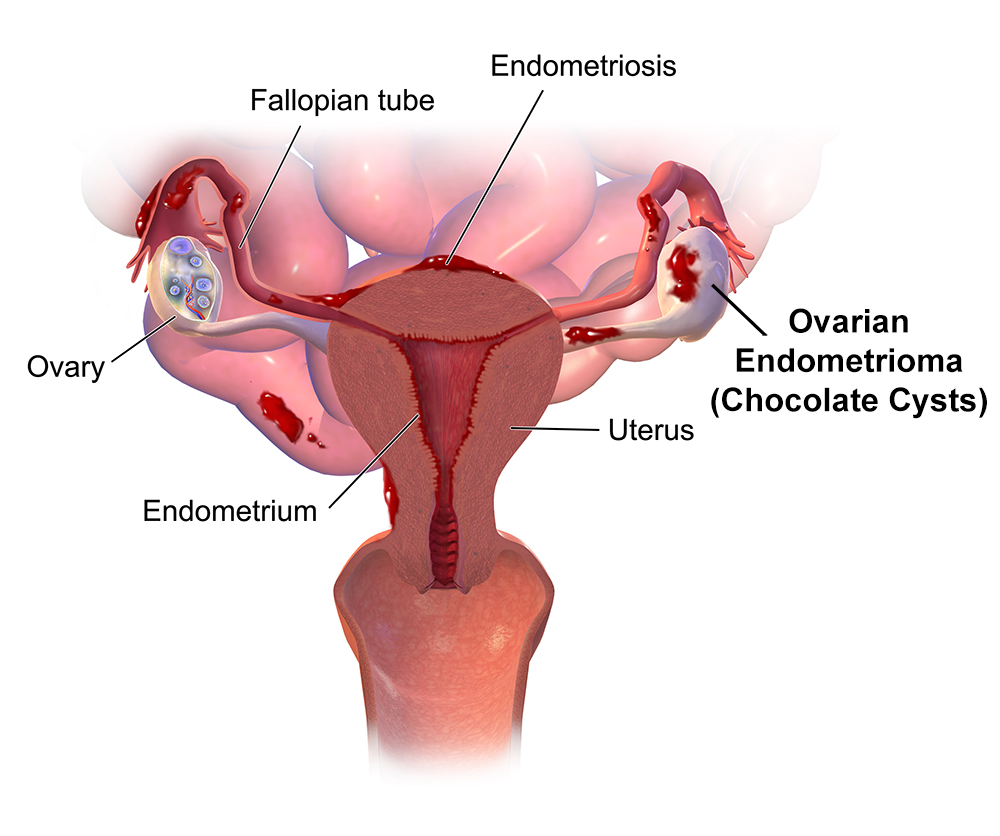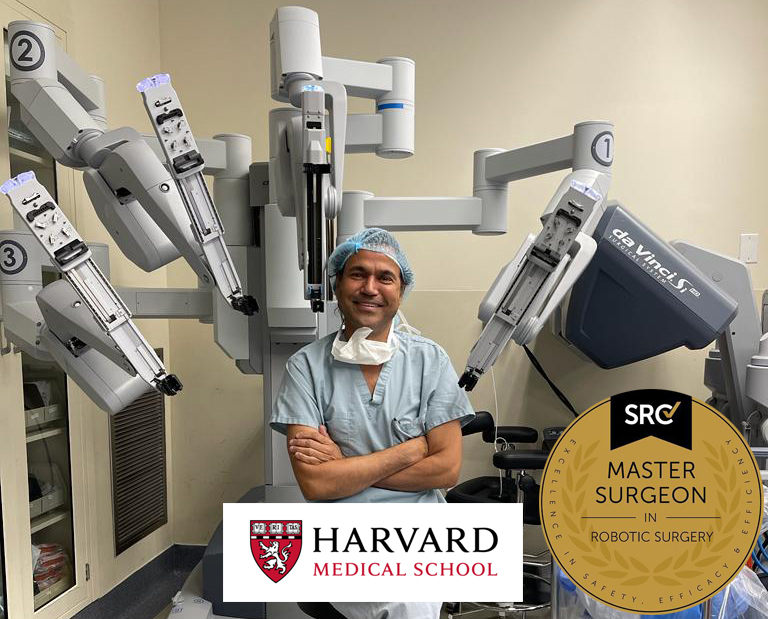Ovarian Endometrioma (Chocolate Cysts)
A chocolate cyst, also known as an endometrioma, is a type of ovarian cyst that is filled with old, dark blood that resembles chocolate.
An endometrioma, commonly referred to as a chocolate cyst, is an ovarian cyst containing dark, old blood that bears a resemblance to chocolate.
It is a result of endometriosis, a condition where the tissue that normally lines the inside of the uterus grows outside of it, leading to the formation of scar tissue and adhesions.

Ovarian Endometrioma (Image source: Blausen Medical, 2014)
Chocolate cysts can cause symptoms such as pelvic pain, bloating, irregular periods, painful periods, painful intercourse, and infertility. They can be diagnosed through imaging tests such as ultrasound or MRI, and in some cases, a biopsy may be needed to confirm the diagnosis.
Treatment for chocolate cysts depends on the severity of symptoms and the individual’s age and desire for future fertility. Options may include pain medication, hormonal therapy, or surgery to remove the cyst or the affected ovary. It is important to seek medical attention if you suspect you may have a chocolate cyst or endometriosis, as early diagnosis and treatment can help prevent complications and improve outcomes.
Endometriomas in the ovaries are quite prevalent and could potentially be found in around 30-40% of women diagnosed with endometriosis.
How Do Chocolate Cysts in the Ovaries Form?
Retrograde menstruation is believed to be one of the possible causes of endometriosis, but it is not the only cause. Retrograde menstruation occurs when menstrual blood containing endometrial cells flows back through the fallopian tubes and into the pelvic cavity instead of leaving the body through the vagina. As a result, blood accumulates in the ovaries, leading to the development of an endometrioma (chocolate cysts).
In women with endometriosis, it is thought that these endometrial cells can implant and grow on other organs in the pelvic cavity, leading to the development of endometriosis. However, not all women who experience retrograde menstruation develop endometriosis, and other factors such as hormonal imbalances and immune dysfunction may also play a role.
Other theories for the cause of endometriosis include genetic predisposition, environmental factors, and abnormalities in the development of the reproductive system. The exact cause of endometriosis is still not fully understood and more research is needed to better understand the condition.
Why are Ovarian Endometriomas Called “Chocolate Cysts?
Ovarian endometriomas are referred to as “chocolate cysts” because of the dark, reddish-brown fluid that fills them, resembling chocolate. These cysts have the potential to rupture suddenly, causing their contents to spill and adhere to the abdominal cavity’s nearby organ walls.
卵巢子宫内膜异位症的症状
The symptoms of ovarian endometrioma or chocolate cysts can vary from person to person. Some common symptoms include:
- Pelvic pain: Dull or sharp pain in the lower abdomen or pelvis that may become more severe during menstruation.
- Menstrual irregularities: Heavy or irregular menstrual bleeding, or spotting between periods.
- Pain during sex: Pain or discomfort during sexual intercourse.
- Infertility: Difficulty getting pregnant or experiencing recurrent miscarriages.
- Digestive symptoms: Bloating, constipation, or diarrhea.
In some cases, ovarian endometriomas may not cause any noticeable symptoms, and they are discovered incidentally during a routine pelvic exam or imaging test. It is important to talk to a doctor if you experience any persistent symptoms or have concerns about your reproductive health.
Diagnosis of Ovarian Endometrioma
The diagnosis of ovarian endometrioma or chocolate cysts typically involves a combination of medical history, physical examination, and imaging tests.
During the physical examination, a doctor may perform a pelvic exam to check for any abnormalities or pain. They may also order imaging tests such as an ultrasound, MRI, or CT scan to confirm the presence of an ovarian cyst and determine its size, shape, and location.
In some cases, a doctor may recommend a laparoscopy, which is a surgical procedure that involves making small incisions in the abdomen to insert a camera and other instruments to visualize and biopsy the cyst.
Additionally, blood tests may be conducted to check for markers of endometriosis or other underlying conditions. A definitive diagnosis of ovarian endometrioma is usually confirmed by microscopic examination of the tissue obtained through biopsy or surgical removal.
Surgical Methods for Ovarian Endometrioma Treatment
There are several surgical methods for treating ovarian endometrioma, including laparoscopic cystectomy, robotic-assisted laparoscopy, and laparotomy. The specific method used depends on the severity and location of the endometrial tissue, as well as the patient’s overall health and preferences. In general, the goal of surgery for ovarian endometrioma is to remove the affected tissue while preserving healthy tissue and organs as much as possible.
Laparoscopic Cystectomy
Laparoscopic cystectomy is a surgical procedure that involves the removal of an ovarian cyst, such as an ovarian endometrioma or chocolate cyst, using minimally invasive techniques.
During the procedure, the surgeon makes small incisions in the abdomen and inserts a laparoscope, which is a thin, lighted tube with a camera attached to it, and other surgical instruments. The camera provides real-time images of the cyst and surrounding tissue, allowing the surgeon to carefully remove the cyst while minimizing damage to healthy tissue.
Laparoscopic cystectomy is generally considered a safe and effective treatment option for ovarian endometriomas, and it has several advantages over traditional open surgery, including smaller incisions, less pain and scarring, and a shorter recovery time. However, as with any surgery, there are some risks and potential complications, including bleeding, infection, damage to surrounding organs, and recurrence of the cyst.
机器人辅助腹腔镜检查
Ovarian endometrioma robotic-assisted laparoscopy is a minimally invasive surgical procedure used to remove endometrial tissue that has grown inside the ovary while preserving the ovarian function.
Robotic-assisted laparoscopy is a type of laparoscopic surgery that uses robotic arms to perform the surgery instead of a surgeon’s hands. This technology allows for greater precision and control during the procedure, and can result in less pain, scarring, and a faster recovery time compared to traditional open surgery.
The cost of ovarian endometrioma robotic-assisted laparoscopy can vary depending on several factors, including your location, the complexity of the surgery, and your insurance coverage.
Ovarian Endometrioma Laparotomy
Ovarian endometrioma laparotomy is a surgical procedure used to remove endometrial tissue that has grown inside the ovary. Laparotomy is an open surgery that involves making a larger incision in the abdomen to access the affected ovary.
The cost of ovarian endometrioma laparotomy can vary depending on several factors, including your location, the complexity of the surgery, and your insurance coverage.
Pankaj Singhal, MD, MS, MHCM
机器人手术外科医生大师
Pankaj Singhal 博士是全球公认的子宫内膜异位症外科医生,在腹腔镜切除手术方面拥有超过 25 年的专业知识,这使他能够充满信心地应对最具挑战性的子宫内膜异位症病例。 Pankaj 医生治疗患有多种子宫内膜异位症相关疾病的患者,从卵巢子宫内膜异位症到影响肠道和其他器官的严重深部浸润性子宫内膜异位症。
Pankaj 医生优先考虑微创手术并提供全面的个人护理。此外,他还是纽约妇科和子宫内膜异位症 (NYGE) 的所有者和创始人,并一生致力于倡导、尊重和治疗患有这种鲜为人知的疾病的女性。他是全美国少数完成超过 5,718 例机器人辅助妇科手术的外科医生之一。

我们接受大多数主要保险计划
便捷的计费选项,全面覆盖。
手术通常由健康保险承保。然而,承保范围可能会有所不同,具体取决于具体的保险计划和保单。一些保险计划可能涵盖广泛的外科手术,包括选择性和必要的手术,而其他保险计划可能对某些手术有限制或排除。
在某些情况下,某些保险计划或计划可能会全额承担手术费用,使患者无需承担经济责任。
请求预约
New York Gynecology Endometriosis
"*" indicates required fields
